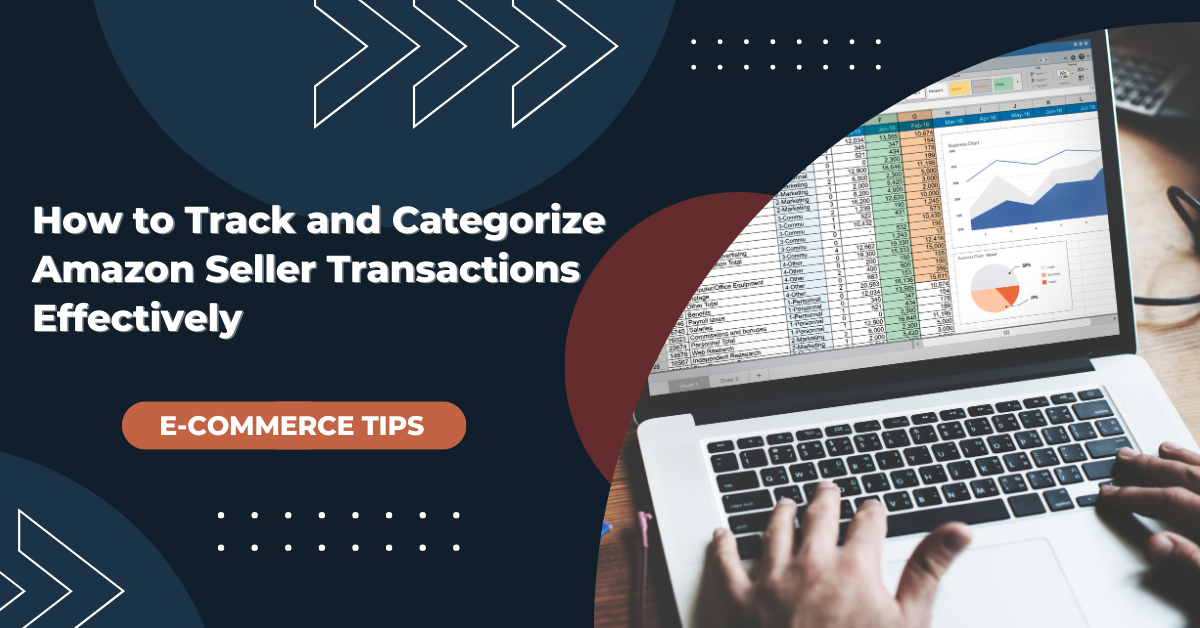How to Track and Categorize Amazon Seller Transactions Effectively
Keeping track of Amazon seller transactions can quickly become overwhelming, especially when you’re managing multiple sales, returns, and expenses.
Understanding how to categorize these transactions correctly is key to staying organized, ensuring accurate financial records, and maintaining compliance with tax laws. In this article, we’ll walk you through the best practices for tracking and categorizing Amazon seller transactions effectively.
1. Set Up a Dedicated Amazon Seller Account
The first step in tracking and categorizing Amazon Seller transactions is to set up a dedicated account for business use. Ensure that your Amazon Seller account is linked to your business bank account to help streamline transactions.
This setup allows you to keep personal finances separate from business finances, making it easier to categorize and track the income and expenses related to your business.
Additionally, consider using accounting software that integrates with Amazon, such as QuickBooks or Xero, to automate the tracking process.
2. Download and Review Your Amazon Seller Statements
Amazon provides detailed statements for every transaction through the Amazon Seller Central dashboard. These statements, known as the “Settlement Report,” include information on sales, fees, returns, shipping costs, and more.
Download these reports regularly, preferably monthly, to ensure you have a clear view of all transactions. These reports can be exported in CSV format, which is ideal for importing into accounting software or for further manual analysis.
Be sure to review each statement to identify any discrepancies, such as unexpected fees or returns, and reconcile them against your records.
3. Categorize Sales and Expenses
Once you have your settlement reports, it’s time to categorize the sales and expenses properly. This step involves breaking down the data into specific categories such as:
- Revenue: This includes gross sales (before any deductions for fees or returns).
- Amazon Fees: These fees include referral fees, subscription fees, closing fees, and advertising costs.
- Shipping Costs: If you are handling shipping yourself, track these costs separately. If you use Fulfillment by Amazon (FBA), shipping costs are typically embedded in Amazon’s fees.
- Returns and Refunds: Keep a separate category for any returns or refunds issued by customers as they impact your overall revenue.
- Advertising Expenses: Track your Amazon PPC (pay-per-click) advertising costs as a separate expense category.
- Inventory Costs: If applicable, track costs related to purchasing inventory, including storage fees if you use FBA.
Using accounting software with preset categories can help simplify this process. If working manually, create a spreadsheet with columns for each category and transaction type, then input the relevant data from the settlement report.
4. Use Amazon’s Reports for Accurate Tax Filing
For accurate tax reporting, Amazon provides various reports that can help you track the sales tax you’ve collected and other important financial details.
The “Tax Document Library” in your Amazon Seller Central account contains information on sales tax collected, and the “Tax Liability Report” helps you calculate the taxes due based on the sales made in different states (if applicable). Be sure to download these reports to assist with your tax filings, ensuring you stay compliant with the necessary tax regulations.
Depending on your location, you may also need to account for international sales taxes if selling globally.
5. Reconcile Your Transactions Regularly
Regular reconciliation is critical to ensure the accuracy of your financial records. Reconcile your Amazon Seller account settlements with your bank account and any linked payment processors, such as PayPal or a payment gateway.
This helps identify any discrepancies or errors between what Amazon reports and what is deposited into your account. Reconciling monthly or even weekly is ideal, as it provides a more immediate view of your financial standing and can help avoid errors before they snowball.
6. Track and Record Your Profit Margins
To effectively manage your Amazon Seller business, you need to track your profit margins consistently. Calculate your net profit by subtracting all fees, expenses, and costs from your gross revenue.
Amazon’s fee structure can be complex, so it’s important to track each expense associated with the sale of a product. Profit margin tracking allows you to make informed decisions about product pricing, advertising strategies, and inventory management, ensuring long-term profitability.
7. Utilize Third-Party Tools for Streamlined Tracking
To further streamline the process, consider using third-party tools designed specifically for Amazon Sellers. Applications like A2X, TaxJar, and Fetcher can automate much of the categorization, reconciliation, and tax tracking tasks.
These tools pull your Amazon data, categorize it, and integrate it with accounting software, which reduces manual work and ensures accuracy. Many of these tools also provide detailed profit and loss reports, which are crucial for financial planning and decision-making.
8. Maintain Detailed Records for Compliance and Future Reference
Lastly, always maintain detailed records of your transactions for tax reporting, financial analysis, and audit purposes. Keep records of all expenses, sales data, Amazon fees, and any communications with customers related to returns or refunds.
This will help ensure you’re fully prepared for tax season or any potential audits. Additionally, having a robust record-keeping system allows you to analyze your performance over time, identify trends, and improve your business operations.
Common Mistakes to Avoid When Categorizing Amazon Seller Transactions
Properly categorizing transactions is crucial to keeping your books accurate and avoiding headaches at tax time.
In this section, we’ll walk through some of the most common mistakes sellers make when categorizing their Amazon transactions and provide tips on how to stay on track.
Misclassifying Income and Expenses
One of the most common mistakes is misclassifying income and expenses. Amazon sellers often treat refunds, reimbursements, and adjustments as income, which can lead to inaccurate profit calculations.
For example, if you receive a reimbursement for lost inventory or damages from Amazon, this should not be recorded as sales income. Instead, it should be categorized as a refund or a separate adjustment.
Failure to Account for Fees and Charges
Amazon charges various fees, including referral fees, fulfillment fees, and storage fees. Sellers may overlook these charges or miscategorize them, which can significantly distort financial statements.
For example, fulfillment fees should be recorded under “Cost of Goods Sold” (COGS) if you’re using FBA (Fulfillment by Amazon), while referral fees are considered sales expenses. Not properly categorizing these fees can make it difficult to track profitability and tax deductions, especially if the fees are significant.
Not Tracking Inventory Changes Accurately
Inventory management is a complex aspect of Amazon Seller accounting. One mistake is not properly tracking the change in inventory levels when products are sold or returned.
If you are using FBA, Amazon will automatically update inventory counts, but you still need to accurately record the cost of goods sold. Failure to adjust inventory for returns, lost items, or unsellable inventory will result in an inaccurate view of the business’s financial health, leading to potential overstatement of profits.
Neglecting Sales Tax
Another key mistake is neglecting the proper categorization of sales tax, especially if you’re selling in multiple states. Amazon automatically collects sales tax in certain jurisdictions, but it’s essential for sellers to distinguish this from actual income.
Sales tax is collected on behalf of the state and doesn’t constitute revenue for the seller, so it should not be included in income. If you handle sales tax manually, tracking the amounts for each jurisdiction correctly and categorizing them separately is necessary to avoid overreporting income.
Overlooking Shipping Costs
Shipping costs are another frequently overlooked expense that must be categorized correctly. Many sellers fail to track the expenses incurred in shipping products to customers or from suppliers to Amazon.
These shipping costs should be properly categorized under “Shipping and Delivery” or “Cost of Goods Sold” depending on the nature of the expense. Shipping costs that are included in the sale price should also be deducted correctly to ensure that the gross margin is not inflated.
Mixing Personal and Business Expenses
A critical error many Amazon sellers make is mixing personal and business transactions in the same account or categorizing them under the same category. This can make it difficult to separate business expenses from personal ones and complicates tax reporting.
It’s essential to maintain separate accounts for business-related expenses and personal transactions, ensuring that only legitimate business costs are categorized as such.
Inaccurate or Incomplete Recordkeeping
Amazon sellers can fall into the trap of not maintaining complete and accurate records. For instance, it’s easy to forget to account for small incidental expenses, returns, or product damage.
Sellers should retain all receipts, invoices, and transaction records, including Amazon’s detailed reports on fees, returns, and other transactions. Incomplete records will make it difficult to calculate accurate taxes, fees, and profits, leading to issues down the line, especially when preparing tax filings.
Get Started Today With CapForge’s Bookkeeping & Tax Services
Take control of your business finances with CapForge. Our expert team makes managing your payroll simple so you can focus on what really matters—growing your business.
Partner with us today and discover the peace of mind that comes from knowing your financials are in good hands.
Send an email to info@capforge.com or contact us at 1-858-633-3573 to get started. Additionally, you can fill out the form below and we’ll be happy to attend to your needs!








